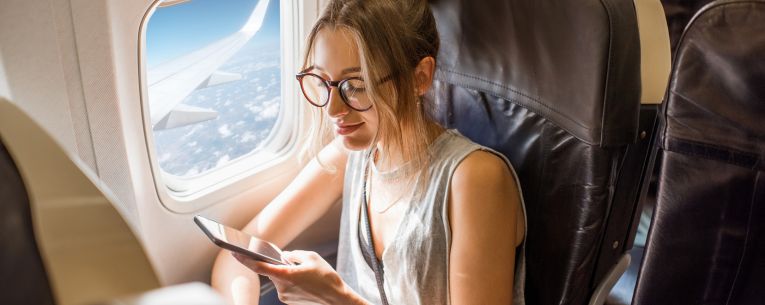“Please make sure all electronic devices are turned off and securely stowed before takeoff. Laptops and mobile devices should be placed in airplane mode.”
You may have heard this message a hundred times… but have you ever wondered why? Why do airlines make you use airplane mode? Will something terrible happen if you don’t?
We have the answers—plus more pro tips for flying with your phone.
What does airplane mode do, anyway?
Airplane mode turns off all wireless and cell signal capabilities on your phone. When airplane mode (or flight mode) is activated, you can’t make or receive calls or texts, connect to anything via Bluetooth, or access Wi-Fi.
In airplane mode, you can use phone features that don’t require the Internet. Alarms still work (although if you’re crossing time zones, your phone won’t show the correct time until you have a Wi-Fi or cellular connection). One benefit of airplane mode: It conserves your phone’s battery power!
Why is airplane mode required while flying in the U.S.?
It’s a safety thing. Cell phones—as well as laptops, handheld gaming systems, e-readers and other devices—emit radio waves that can affect navigation and radar equipment as well as cause interference in pilots’ headsets.1
Also, it’s U.S. law. Federal regulations say “cellular telephones installed in or carried aboard airplanes, balloons, or any other type of aircraft must not be operated while such aircraft are airborne (not touching the ground). When any aircraft leaves the ground, all cellular telephones on board that aircraft must be turned off.”2
Flying in Europe is a different story. In 2023, airlines began providing 5G technology onboard, allowing passengers to make and receive calls and texts.3 EU 5G networks use a different frequency than American ones, and so they don’t affect plane equipment.
But really, what happens if you don’t turn on airplane mode during a flight?
In 2017, Allianz Travel Insurance surveyed more than 1,500 Americans and learned that 40% of people don’t always put their phone on airplane mode. Almost 14% of people have secretly snuck a text message or call during a flight. “If using a phone on a plane really is dangerous,” they reason, “why are we allowed to bring phones aboard?”
It’s true that there have been no reports of planes crashing or other serious in-flight incidents caused by cell use on board planes. The extent of phones’ effect on aviation technology hasn’t been studied in-depth. Anecdotally, however, pilots say they can hear background noise and interference from phones while flying, especially when they’re landing and mobile phones begin to make contact with towers again. Do you really want to distract your pilot while they’re speaking with air traffic control and trying to execute a safe landing?
Are you allowed to use your phone at all on a plane?
Sure! Once it’s in airplane mode, you can safely use any feature on your phone. You can also enable Wi-Fi to connect in flight. Just leave the cell service off.
Is it rude to use your phone while the flight attendant is giving the pre-takeoff safety speech?
Yes. At least pretend to pay attention.
Can you fly with a power bank?
Power banks are allowed on planes… but only in your carry-on luggage. Why? Because they contain lithium batteries, which can catch fire if they’re damaged or if they short-circuit. It might seem counter-intuitive, but this is the safer option. If a battery fire occurs in the plane cabin, flight attendants can extinguish it. If the fire occurs in the cargo hold, it may go unnoticed and cause a disaster.
Learn more: 20 Things You Should Never Pack in Checked Luggage
What happens if your phone dies before your flight and you can’t access your boarding pass?
You’re about to get on the plane, and then you realize your screen has gone black. If your phone battery is dead, how can you show your mobile boarding pass?
Don’t panic! This happens all the time. Ask the gate agent or an agent at the airline’s customer service desk for help. They should be able to print a pass for you. To avoid situations like this, it’s always wise to print all your travel documents: boarding passes, itineraries, visas, and travel insurance plans.
Here are a few tips to prevent your phone from dying while you’re traveling:
- Always take a screenshot of your boarding pass and other travel documents. That way, you can access it without Wi-Fi (and use less battery power, too.)
- Use low-battery mode and/or airplane mode to conserve battery life.
- Reduce screen brightness.
- Close all apps.
- Turn off notifications.
Is it safe to use airport Wi-Fi and public chargers?
Have you heard warnings about “juice jacking”? The FCC and the FBI have put out alerts about this practice, which refers to hackers gaining unauthorized access to your phone through a compromised charging station. However, the risk is low if not nonexistent, tech experts say. “There are no documented cases of juice jacking ever taking place in the wild,” according to Ars Technica. Your phone should notify you if any device attempts to access it.4
Public Wi-Fi networks, like those in airports, are generally considered to be safe. These days, almost all websites are encrypted (indicated by the “https” in the URL), which means your browsing data is secure.5 If you have sensitive information on your phone or laptop, consider using a virtual private network (VPN).
Use common sense, too. If a particular network looks like it may not be the official airport Wi-Fi, don’t access it or enter any credit-card info.
How can I keep my phone secure while traveling?
Assume the worst-case scenario: Your phone will get lost or stolen during your trip. Think about what would worry you the most, then take steps to reduce the risk before you leave. This may include:
- Deleting or signing out of any apps with personal information (such as financial apps)
- Backing up any important data or treasured photographs
- Packing hard copies of essential travel documents
- Enable travel mode on your password manager, which removes vaults with sensitive information
- Enable Find My Phone or another service that can help track lost devices. (Just don’t chase or try to confront a thief yourself.)
- Download backup access codes (if available) for two-factor account verification
Purchasing travel insurance is essential! If your phone is stolen, or if it’s lost or damaged by your common carrier—like the airline—your travel insurance’s baggage benefits may cover the loss (up to the maximum limit in your plan). Get a quote for travel protection.
Also, be sure to download the Allyz® TravelSmart app before you go. One of the best free apps for travelers, Allyz TravelSmart helps you solve travel dilemmas by putting crucial information at your fingertips. Access your travel insurance benefits, connect with 24-hour assistance, call local emergency numbers, get real-time travel alerts and more.
Related Articles









Share this Page